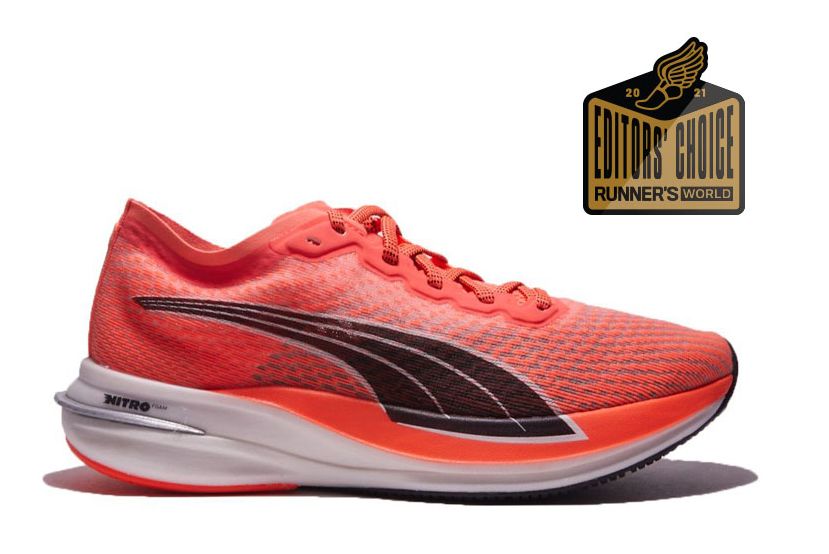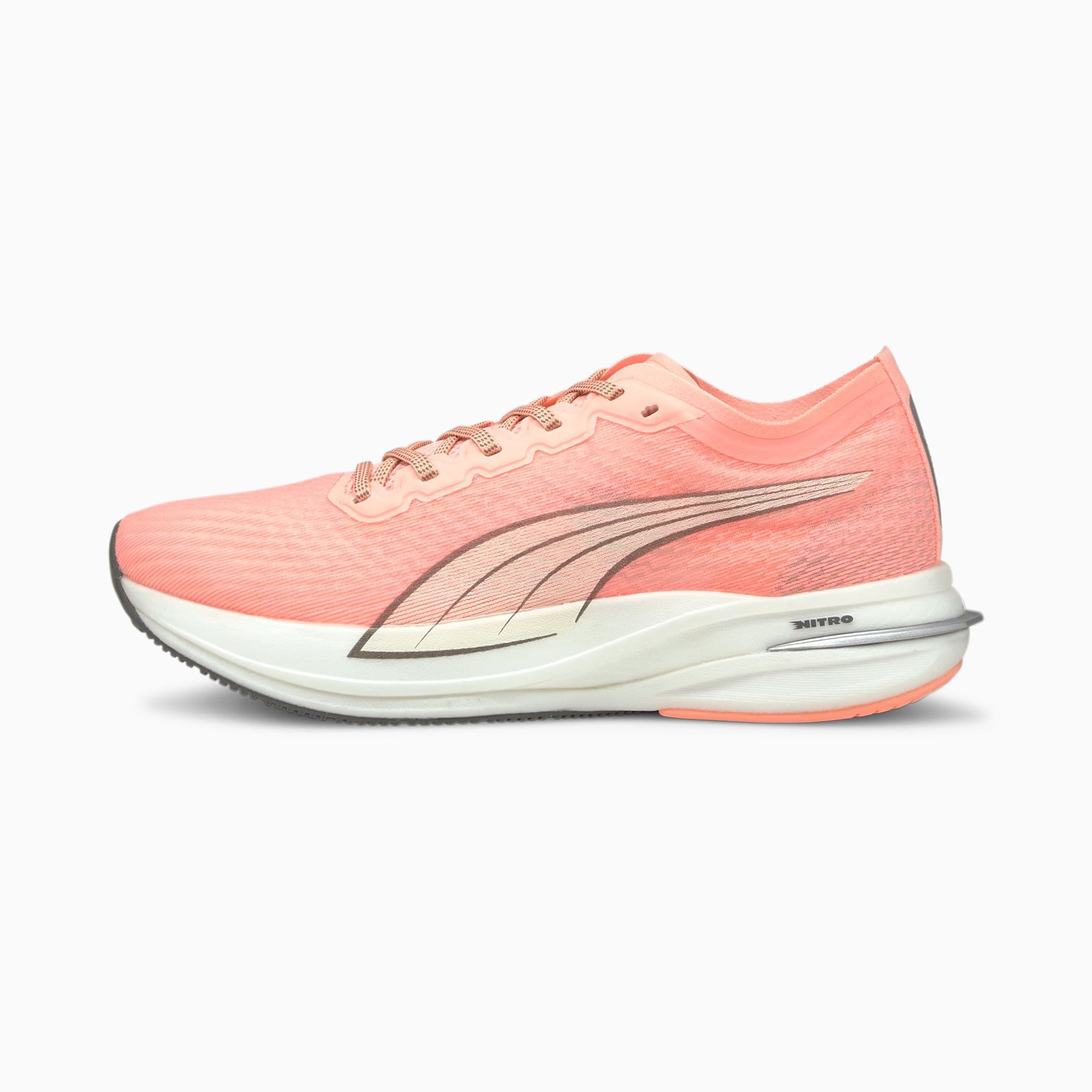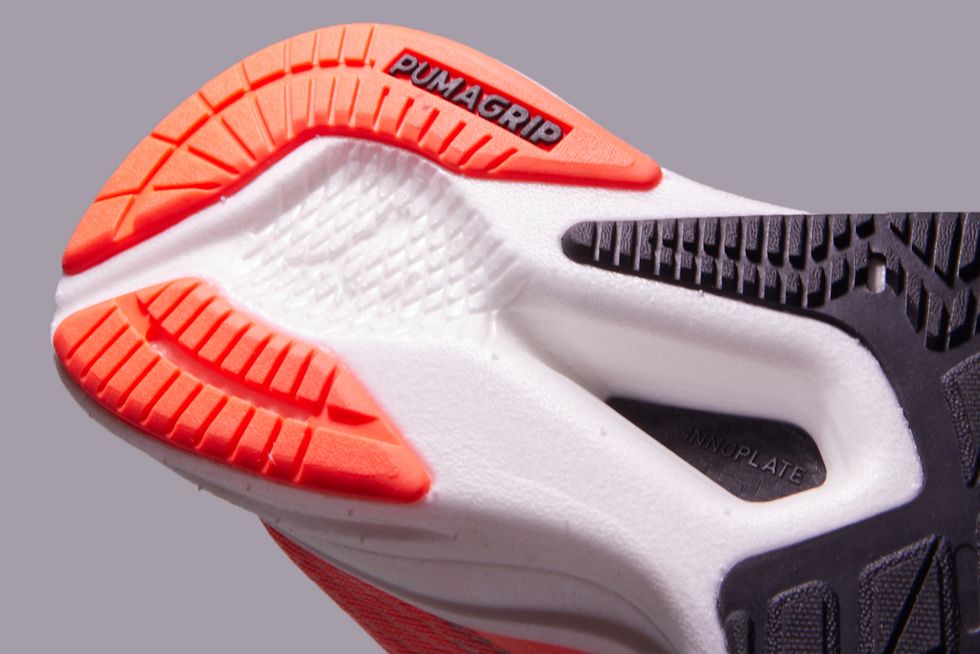The RW Takeaway: A lightweight, bouncy foam and carbon-fiber plate deliver plenty of speed for all of your uptempo workouts.
- Nitrogen-infused foam makes the shoe feel lively underfoot.
- Women’s models are tailored for a better fit.
- It’s not as soft or fast as shoes like the Nike ZoomX Vaporfly Next% or Saucony Endorphin Pro
Price: $160
Type: Road
Weight: 9.3 oz (M); 7.5 oz (W)
Drop: 10 mm
More From Runner's World

One of the most exciting shoes of 2021 comes from an unexpected brand: Puma. Yes, for real. Puma has been working behind the scenes to re-establish itself as a manufacturer of serious performance running shoes. The Deviate Nitro is the first indication that the company is on the right track. Like just about every other brand, Puma wanted a shoe with a carbon-fiber plate to earn some cred. This is that shoe.
Like other carbon-plated speedsters, the Deviate Nitro also leverages lightweight, bouncy foam—it’s TPE, not the pricier, springier Pebax that some other brands use—which makes you want to kick your heels to your butt. The foam is nitrogen-infused, giving it a responsive sensation underfoot, and it proved durable in our testing. That foam choice also means the shoe isn’t quite as soft or as fast as some of the latest top-end racing shoes, but at just $160 it’s an affordable, versatile option that you can use for training and racing.
“These shoes blew me away,” gushed one tester. “I wore them for everything from a 9-minutes-per-mile cruise to a 10K PR, and they felt fully capable doing both.”
The one knock: Padding on both sides of the heel is a bit high and thick, which could create a little slippage for some runners.
Affordable Foam Package
A quick primer on foams: We’ve had EVA in shoes for decades because it’s cheap. It’s also pretty easy to work with, fairly durable, and reliably consistent. But, nearly a decade ago, Adidas launched Boost, a TPU-based foam, which was far bouncier, though heavier and more costly. More recently, Nike put Pebax in its Vaporfly line of racers, and the shoe game hasn’t been the same since. Pebax is extremely light, extremely soft, and extremely bouncy—it’s also extremely expensive. So, every brand is working with some premium formulation right now—Puma just launched its Deviate Elite—but also offers affordable options with similar construction so you can still feel fast without dinging your credit card.
That’s what the Deviate Nitro is all about. At $160, it’s not a budget shoe, to be sure, but it’s a relative bargain for the features it packs and the performance it delivers. Using TPE instead of Pebax helps keep the cost down. The trade-off is you don’t get as much energy return. With Pebax, you can actually feel your foot sink into the foam on every landing, yet explosively bounce right back up with each toe-off. The Deviate Nitro doesn’t have that sinking feeling, yet it’s still well-cushioned and the toe-off is quick and lively as you push forward.
With tall stack heights (the thick sole), the shoe is intended for max cushioning and long runs. For many of us, it delivers reliable comfort when runs extend into double-digit distances. But, we also regularly reach for it on track days or for tempo runs. There’s plenty of foam under your foot, but it doesn’t feel mushy. In fact, it feels quite firm when you’re turning up the speed.
Where Have We Seen This Upper?
The first thing everybody said when getting a pair of these shoes to test was “Hey, that’s a Peg Turbo.” The mesh so closely resembles v2 of that shoe it’s a small wonder the Swoosh didn’t send a cease-and-desist. In any case, its structure holds your foot comfortably snug. It’s incredibly breezy and will perform well in warm weather—our testers got these shoes during the winter and all reported chilly feet.
Some testers felt the shoe ran a little large, while others praised its comfort—that conflicting feedback is mostly due to what’s happening back at the heel. Inside the shoe, Puma placed fairly thick pads meant to help lock the back of your foot down to the sockliner. But the pads’ size and shape actually make the shoe slip—or worse, blister—for some runners. Our faster testers, however, absolutely loved the fit of the shoe. Then again, that crew has the good fortune of being able to run in just about anything.
“I usually have an issue with heel lift on some shoes, but had no issues in these,” said one tester who regularly averages 7:45 pace on his training runs. “No hot spots, no pinch points, no numbness. Nothing!”
The women’s version is built to have a narrower heel, lower instep, and a sculpted arch for a better fit. But, even so, the women who tested this shoe felt the heel, as already mentioned, could be improved.
What One Tester Said
Chris P. | 5’10” | 150 lb.
Arch: Medium | Gait: Neutral | Footstrike: Midfoot
“In my mind Puma wasn’t a brand I’d ever consider when buying running shoes. I went in not expecting much at all and was proven wrong just walking down the stairs before my first run in these. I absolutely loved running in them. I generally run on trails about 75 percent of the time but these shoes were so fun and comfortable to run in that I ended up running on the road a bunch more this month. They were also so inspiring I went out and set a 10k PR and my feet felt great the whole time. I was truly impressed with these shoes. Well done Puma.”
Jeff is Runner-in-Chief for Runner's World, guiding the brand's shoes and gear coverage. A true shoe dog, he's spent more than a decade testing and reviewing shoes. In 2017, he ran in 285 different pairs of shoes, including a streak of 257 days wearing a different model.














